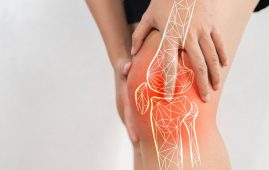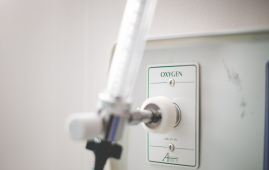

In recent years, research on traumatic brain injury has proliferated, from the football field to the battlefield. Modeling the mechanical forces that compress, strain, and twist the brain tissue and cause harm that can be temporary or fatal is essential to understanding brain injury.
Stanford University researchers claim to have used artificial intelligence to create a model of how brain deformations translate into stresses. They believe their method may help explain why and when concussions sometimes result in permanent brain damage while other times they do not.
“The problem in brain modeling to date is that the brain is not a homogeneous tissue—it’s not the same in every part of the brain. Yet, trauma is often pervasive,” said Ellen Kuhl, professor of mechanical engineering, director of the Living Matter Lab, and senior author of a new study appearing in the journal Acta Biomaterialia. “The brain is also ultrasoft, much like Jell-O, which makes both testing and modeling physical effects on the brain very challenging.”
Going to the library
Researchers who want to study brain trauma are forced to select from a library of dozens of material models, some dating back almost a century, to help calculate the stresses on the brain.
For decades, scientists have developed these models for soft materials with inscrutable names like the “neo-Hookean Model for Plastics and Rubber,” the “Demiray Model for Soft Tissues,” and the “Ogden Model for Rubber-like Solids.” But a model that works for a certain type of stress—tension, compression, or shear—may not work for another. Similarly, a model that might work for one region of the brain might not work for another.
The new approach takes a model-of-models tack, using artificial intelligence to discover which model, out of more than 4,000 possibilities, best explains the behavior of the brain. In the past, selecting the best model was a hit-or-miss process that depended largely on user experience and personal preference.
“We take user selection out of the equation by allowing machine learning to examine the data and decide which model works best,” adds Sarah St. Pierre, a doctoral scholar in Kuhl’s lab and a co-author of the paper. “Automating this process lowers barriers to model the brain. Now, every Stanford student can do this.” Once machine learning has discovered the best model, it’s easy to relate it back to the models that generations of researchers have proposed.
Transformative insights
The approach, known as a Constitutive Artificial Neural Networks, was developed by Kevin Linka before he joined the Living Matter Lab as a postdoc to apply his method to the brain.
“We provide the network with all existing constitutive models developed over the last century. And the AI does a mix-and-match to find the best option. This is impossible to do by hand,” Linka said. “Now, we’ve effectively discovered a new model that makes us more confident in studying the mechanical stress in the brain.”
Constitutive Artificial Neural Networks, in contrast to traditional off-the-shelf neural networks, offer fresh perspectives on the physics of the brain. The team cites as just one illustration how they have precisely measured physically significant factors like variable shear stiffnesses in the cortex, basal ganglia, corona radiata, and corpus callosum at precisely 1.82, 0.88, 0.94, and 0.54 kilopascals respectively.
The force from a blow to the head, for example, and the ensuing deformation of the brain tissue are related by the shear modulus. By these standards, the corpus callosum, the network of nerves that connects the two hemispheres of the brain, is more than three times as stiff as the cortex, the grey, outer layer of the brain.
Researchers studying brain damage now have better expertise to recreate and comprehend the origins of brain injury. This may serve as motivation for developing additional safeguards or curative procedures. Kuhl’s team has worked with Dassault Systemès Simulia, a leading provider of simulation software, to integrate automated model discovery right into their analysis workflow in order to apply this knowledge to engineering practice.
“What’s really most exciting about this research,” Kuhl said, “is that Constitutive Artificial Neural Networks could induce a paradigm shift in soft tissue modeling, from user-defined model selection to automated model discovery. This could forever change how we simulate materials and structures.”
more recommended stories
 Osteoarthritis Genetics Study Uncovers New Treatment Hope
Osteoarthritis Genetics Study Uncovers New Treatment HopeOsteoarthritis- the world’s leading cause of.
 Antibody Breakthrough in Whooping Cough Vaccine
Antibody Breakthrough in Whooping Cough VaccineWhooping cough vaccine development is entering.
 Scientists Unveil Next-Gen Eye-Tracking with Unmatched Precision
Scientists Unveil Next-Gen Eye-Tracking with Unmatched PrecisionEye-tracking technology has long been a.
 Men5CV: Hope for Ending Africa’s Meningitis Epidemics
Men5CV: Hope for Ending Africa’s Meningitis EpidemicsA landmark global health study led.
 Stem Cell Therapy Shows 92% Success in Corneal Repair
Stem Cell Therapy Shows 92% Success in Corneal RepairA groundbreaking stem cell therapy known.
 Gene Therapy for Maple Syrup Urine Disease
Gene Therapy for Maple Syrup Urine DiseaseResearchers at UMass Chan Medical School.
 How Fast Are Your Organs Aging? Simple Blood Test May Tell
How Fast Are Your Organs Aging? Simple Blood Test May TellNew research from University College London.
 HEALEY Platform Accelerates ALS Therapy Research
HEALEY Platform Accelerates ALS Therapy ResearchA New Era of ALS Clinical.
 Low-Oxygen Therapy in a HypoxyStat Pill? Scientists Say It’s Possible
Low-Oxygen Therapy in a HypoxyStat Pill? Scientists Say It’s PossibleA New Approach to Oxygen Regulation-HypoxyStat.
 Early Alzheimer’s Diagnosis with Advanced Tau Test
Early Alzheimer’s Diagnosis with Advanced Tau TestA New Biomarker Test Promises Early.

Leave a Comment